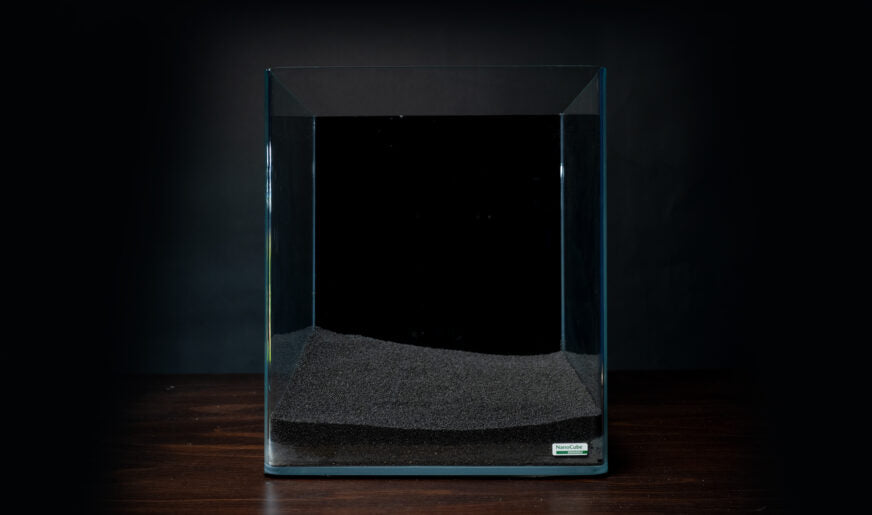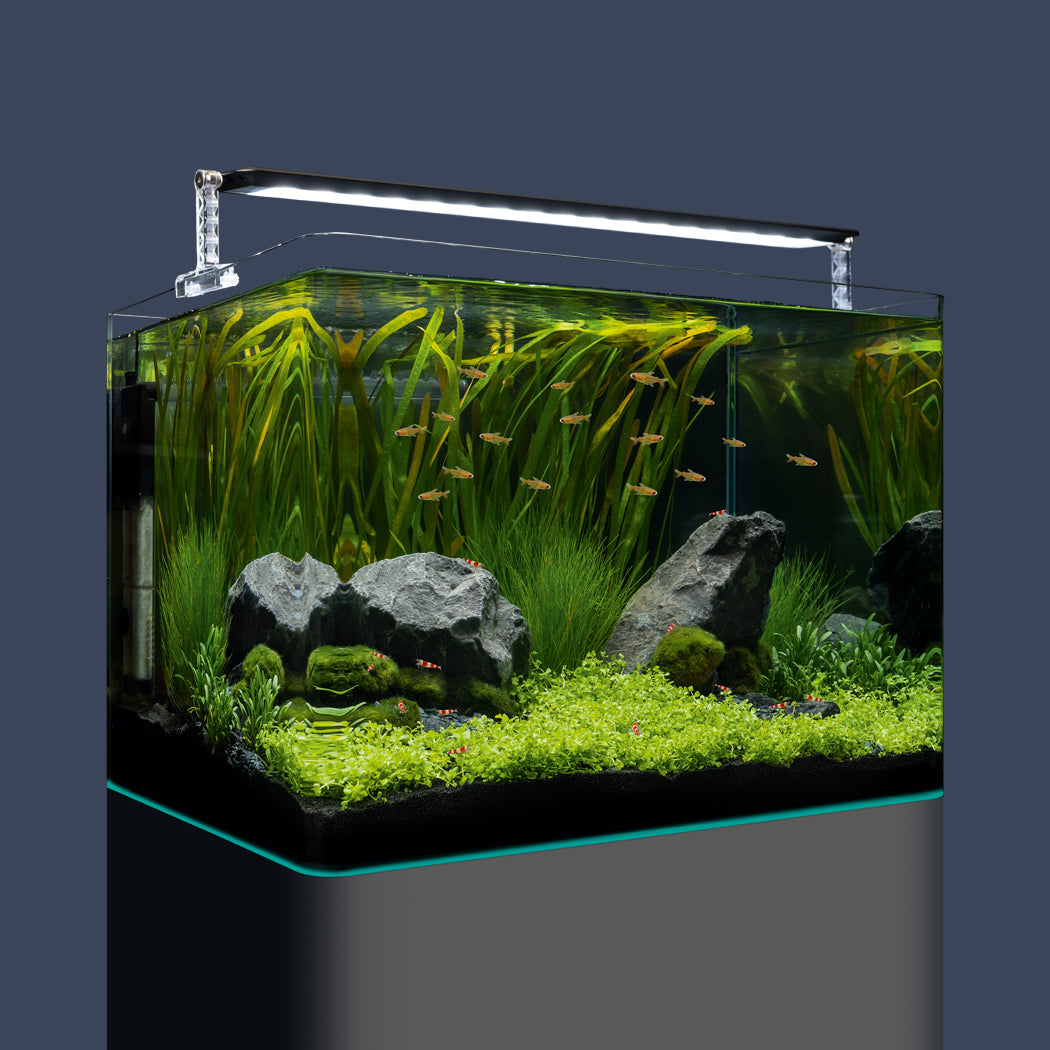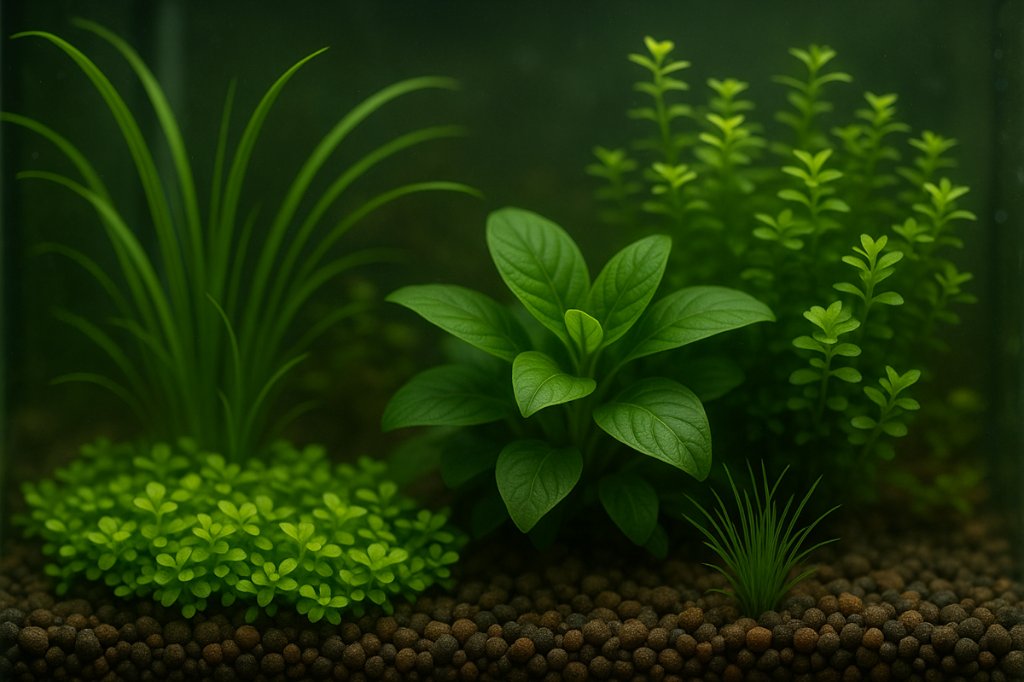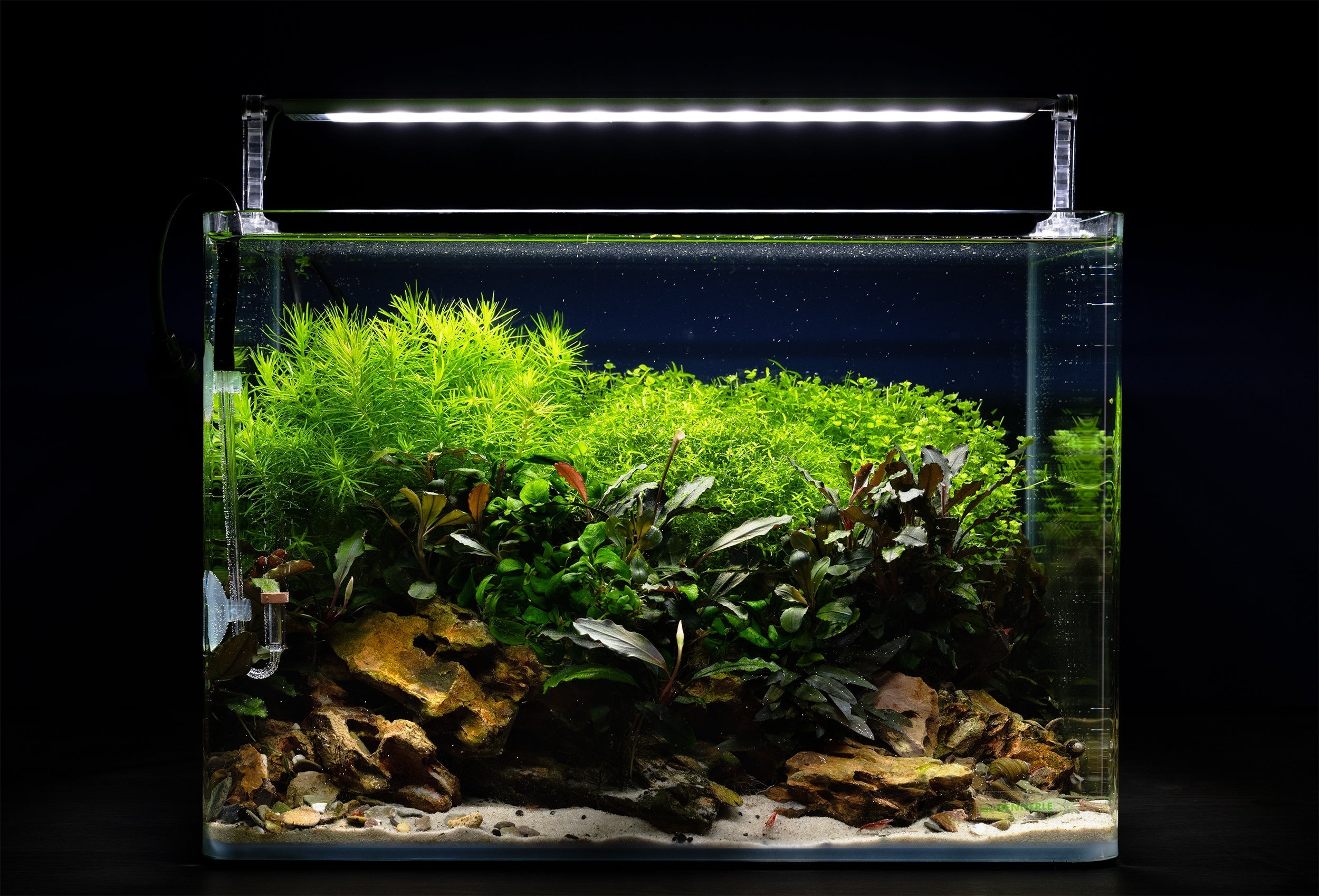Experience nature...
A naturally furnished, harmonious aquarium brings a positive mood into every room, not least through its decorative effect. The view into the tank has a calming and stress-reducing effect and allows you to observe nature at close range. An aquarium creates understanding for ecological relationships and brings nature directly into your living environment.
In an aquarium, a small world lives within itself – a biological system in which all factors influence each other and which must be in balance. That's why we at Dennerle have always taken a holistic view of the aquarium.
Which aquarium suits me?
From the small nano aquarium to the large room divider, you have the full selection. To help you decide, consider the following: Do you want to keep certain animals or plants? You should then select the aquarium according to their requirements. Or do you want a special aquarium size or shape? In this case, you should choose the stock to match the tank.
Just a few examples to give you an idea: In a 20 L Nano Cube you can keep shrimps, the Nano Tank 35 fits very well for a fighting fish, while the Nano Tank 70 is a perfect aquarium for an aquascape.
You can find even more examples in our guide: Types of aquaria.
The substrate
Most aquarium plants are originally marsh plants that readily absorb nutrients through their roots, and require a good foundation to thrive. Gravel and sand are low in nutrients, and the supply is insufficient for healthy growth, especially for more demanding plants. With a growing medium, they receive a reliable, constant supply of nutrients through their roots. Only vigorously growing plants represent serious competition for annoying algae and counteract excessive algae growth. The right substrate structure is therefore one of the key factors for a biologically well-functioning aquarium.
Option 1: Nutrient substrate + aquarium gravel 1 – 2 mm
The Dennerle nutrient soil is placed under the actual substrate as a fertilizer layer. Thanks to its long-term effect, it retains important plant nutrients for 8 years or more, and its buffer function allows excess nutrients to be absorbed from the water and released again as required.
Tip: you pour in the nutrient substrate at a distance of approx. 1 – 2 cm from the aquarium pane, it will not be visible from the outside later on.
Choosing the right aquarium gravels
Fish and shrimp feel more comfortable over darker gravel and show more beautiful colors. The correct grain size of the substrate is important: 1 – 2 mm grain size is optimal for larger aquariums, 0.7 – 1.2 mm has proven itself in nano aquariums. This way, a certain water exchange still takes place in the bottom, but food remains cannot disappear between the gravel grains. If, on the other hand, the gravel is too coarse or too fine, putrefaction processes in the bottom and the formation of harmful putrefactive gases can occur.
Option 2: Soil
Particularly popular with aquascapers, shrimp breeders and plant aquarists, Soil is made from natural soils and baked at low temperatures. It is considered an active substrate because it lowers water hardness, making the water softer. This lowers the pH, which many tropical fish, shrimp and plants like – it's very close to the conditions in their natural habitats.
However, Soil wears out like a battery, so it needs to be replaced every 1 – 2 years when its effectiveness wears off. Those who keep burrowing fish like armored catfish will not be happy with Soil, as it can cause permanent water turbidity.
The water
Filtering
The filter absorbs turbidity from the water and is home to a large number of filter bacteria that biologically break down pollutants – for clear, clean and healthy water. In order for them to work reliably, the filter must be running constantly. In a planted aquarium, the tank contents should be filtered through approx. 1 – 2 times per hour.
In an aquarium, a rather slow, steady water movement is needed to ensure that nutrients reliably reach all plants and waste is removed. Most aquarium plants do not like too strong a current anyway – in nature they grow in rather calm water sections, not in the white water zones. The filter current also provides movement of the water surface, which promotes gas exchange in the aquarium and brings oxygen into the water.
The fewer plants and the more animals in the aquarium, the more oxygen should be introduced by moving the water surface. In particularly heavily planted aquariums, the oxygen consumption of the plants can become noticeable at night. In these cases you should aerate your aquarium overnight or let the water surface move accordingly by the filter current.
Whether you choose an internal filter, an external filter or a backpack filter is a matter of taste. An internal filter sits in the aquarium to save space, while an external filter often offers a slightly higher filtration capacity. The hang-on or backpack filter combines the advantages of both types. It is always important to have as large a filter surface as possible for the cleaning bacteria.
The heater
Often tropical fish are kept in the classic community aquarium, which need a water temperature of 24 – 25 °C to feel comfortable. For many shrimp species for the nano aquarium, the room temperature of 20 – 22 °C is sufficient, because these animals often come from the cooler waters of the subtropics. A good quality heater is important for control accuracy and safety. You should always check the indicated temperature with an additional thermometer – heaters can fail or overheat.
The Lighting
Without light energy, plants cannot photosynthesize, make sugar, or grow. In nature the sun provides them with the light they need, in the aquarium it is the lighting. Too little or too much light will cause plants to care or even algae growth, so it's important to know how much of it your aquarium plants need. You can usually find their light requirements on the label.
The measure of illuminance is luminous flux, measured in lumens (lm). This specification can be found on every light source.
Guide values:
- 15 lumen/L = weak illumination
- 30 lumen/L = medium lighting
- 60 lumen/L = strong illumination
So if the LED fixture packaging states a luminous flux of 3,200 lm and your aquarium is 100 L in size, you will have an average illuminance of 3,200 lm / 100 L = 32 lm/L.
The animals
Fish: Popular species
For many, an aquarium is unthinkable without fish. When choosing fish, remember that the fish does not have to match your living room decor, but the living conditions in your aquarium! Be sure to consider the different requirements for water values, temperature, aquarium size, and also whether the fish needs conspecifics to feel comfortable, or if it will be happy as a pair or even alone.
Here we introduce you to some popular aquarium fish that are comfortable in soft to medium hard water in an aquarium of 60 liters or more.
Trigonostigma espei
- Red wedge danio
- 4 cm; 24 – 26 °C; middle to top; schooling: 7 – 15
- Peaceful, relatively calm fish from Southeast Asia that does not like it too bright. Omnivorous.
Betta splendens
- Siamese fighting fish
- 6 cm; 24 – 26 °C; Solitary
- Air breathers from Southeast Asia. Partly very aggressive, ideal in single keeping from 30 liters. Carnivores.
Paracheirodon innesi
- Neon tetra
- 4 cm; 22 – 24 °C; middle to top; swarm size: 7 – 15
- One of the most popular aquarium fish from South America, relatively easy to maintain. Omnivorous.
Tanichthys albonubes
- Cardinal fish
- 6 cm; 16 – 22 °C; middle to top; swarm size: 7 – 15
- Undemanding peaceful beginner fish from Southeast Asia. Omnivore.
Corydoras hastatus
- Sickle Spotted Catfish
- 3 cm; 23 – 25 °C; bottom; swarm size: 10 – 20
- Small scurrying catfish from South America. Omnivore with emphasis on animal food.
Please note:
In Germany, the "Gutachten über Mindestforderungen zur Haltung von Zierfischen" ("Expert opinion on minimum requirements for the keeping of ornamental fishes") of the BMELV, which stipulates a minimum aquarium size of 60 liters, serves as the basis for keeping ornamental fish.
In Austria, the permanent keeping of fish in aquaria smaller than 60 liters is prohibited by law.
Which fish are suitable for me?
For beginners, easy-care and compatible fish species are ideal – in the beginning, mistakes can simply happen that difficult-to-hold species with special requirements for food or water would not forgive. As a rough rule of thumb for fish stocking in the aquarium, calculate 1 cm of fish per 2 liters of aquarium water. This figure refers to adult fish! Ornamental fish from the pet shop are usually still young and therefore smaller.
As a rule of thumb you should keep in mind that the smaller your aquarium is, the fewer different fish species you should use. Especially with small aquariums you should pay attention to the zone in which your new fish live and select the stocking so that the fish do not get in each other's way.
In a 150 cm aquarium you can happily keep 2 – 3 schools of different fish and additionally 1 – 2 species of bottom fish, in 60 liters it is better to limit yourself to one group of schooling fish and one species of bottom fish. This way a good group size is still possible without it getting too crowded.
Please do not put all the fish in at once. If no nitrite is detectable after the run-in phase, get algae eaters first and see how the aquarium develops. This will allow the filter bacteria to adapt to the slowly increasing load.
If everything is working well so far, you can add more fish after about 2 weeks and gradually increase the fish stocking until the final stocking. Overcrowding can lead to ugly algae problems and diseases in the fish.
Fish: Feeding
Most aquarium fish are omnivorous, meaning they are omnivorous and feed on both animal and plant foods. Herbivorous fish are pure vegetarians, while carnivores are carnivores. You can tell the preferred feeding region in the aquarium by the mouth position. Fish with an upper mouth like to eat insects from the water surface and like long floating food, fish with a lower mouth graze hard surfaces and like to eat biofilms and algae.
As in nature, you should feed your fish a varied diet. Granulate and flakes are available as dry food, but also live food or frozen food. We have composed our Dennerle fish food according to the model of nature, it consists of only the best ingredients and takes into account the needs of your fish.
Large fish can eat smaller food, but small fish cannot eat large food! Therefore, the food particles should be no larger than the diameter of the eyes.
Distribute the food on the water surface so that all fish get something and have to "work" a little for their food. They also have to search actively in nature. To avoid nutrient surpluses, feed only as much as your fish will eat in 1 – 2 minutes. Young fish in growth are fed 2 – 3 times daily, adult fish 1 – 2 times daily.
One fasting day per week or even a weekend without feeding does not harm adult fish – they do not always find something to eat in nature. An optimally fed fish has a moderately filled "belly". When malnourished or sick, the belly is sunken; when overfed, the belly appears fat and bloated.
Shrimp: Popular species
A good stock for nano cubes are dwarf shrimps – here you have a wide choice among different species and colors.
Neocaridina are especially suitable for beginners. They tolerate soft to hard water, do well at room temperature and are very eager to reproduce. There are many different colors of them: Red Sakura, Yellows, dark blue Blue Dreams, light blue Blue Jellys, Green Jade, Orange Sakura, Chocolate, Black Sakura, transparent White Pearls with bright white eggs … Most colors have a striped variety with a bright center, called "Rilis". If you want to mix the colors, you should be prepared for wild colored offspring. It is better to stick to one color.
There are many varieties of bee shrimp (Caridina logemanni) – red bees, black bees, taiwan shrimp, blue bolt, … Bee shrimp are a bit more difficult to keep; they need soft water and feel very comfortable especially on soil. If the conditions in the aquarium fit well, they are also quite eager to reproduce.
The same is true for the black or red striped tiger shrimp with transparent or blue body (Caridina mariae). They tolerate soft to medium hard water.
The very robust Amano shrimp (Caridina multidentata), on the other hand, are a case for larger aquariums with an edge length of 60 cm or more. They do not reproduce in freshwater.
Shrimp: Feeding
Dwarf shrimp are omnivores with an emphasis on vegetable food. Some brown autumn leaves as permanent food in the aquarium is advisable. Otherwise they like to eat scalded nettle leaves and other green food. Vegetables in the aquarium, on the other hand, can lead to problems with germ contamination. A very good alternative to fresh feeding is the food range from Shrimp King: basic food, mineral food, protein food and snacks provide a varied, species-appropriate shrimp diet.
The plants
Plants are much more than mere decoration in an aquarium. Plants turn an aquarium into a living ecosystem, they are simply the key to a smoothly functioning aquarium. Together with the animals, they form an ecological cycle and recycle the nutrients in the water that are brought in by feeding the animals. This can help prevent algae infestations and even displace disease germs! They also provide retreats for aquarium animals and are real lifesavers, especially in aquariums with young animals. In aquariums with healthy plant growth, experience has shown that fish are healthier and grow older than in aquariums with little or no plant growth.
You should plant 70 – 80 % of the bottom surface, and in the beginning about half of the plants should consist of fast growing species (especially stem plants) – this way algae hardly have a chance from the beginning.
For the background, tall growing plants are suitable, usually stem plants are chosen for this. In the middle ground you place half-high plants, while mosses, low-growing or lawn-forming species are well suited for the foreground. Stem plants should be shortened from time to time so that they grow compact and bushy. Ground covers also need to be trimmed from time to time.
Perennials, mosses and ferns are best not placed in the substrate, but tied to roots or stones or glued on with plant glue. Mosses can simply be placed on the substrate in areas with little current or tied onto a plant grid.
Popular starter plants
Stem plants
- Ludwigia repens "Rubin"
- Rotala sp. "Grün"
- Alternanthera reineckii
- Bacopa carolineana
Rosette plants
- Cryptocoryne wendtii "Braun" / "Grün"
- Cryptocoryne sp. "Flamingo"
- Echinodorus "Green Chamäleon" / "Red Chamäleon"
Sit-on plants
- Bucephalandra pygmaea "Bukit kelam"
- Anubias barteri var. nana "Bonsai" / "Gold" / "Pinto"
Ferns
- Microsorum pteropus "Petite" / "Trident"
Mosses
- Taxiphyllum barbierei
- Vesicularia montagnei
- Taxiphyllum sp. "Flame"
Carpet
- Eleocharis pusilla
- Glossostigma elatinoides
- Lilaeopsis brasiliensis Hemianthus callitrichoides




Share:
What do I need carbon dioxide for?
Beginner Guide – Part 2